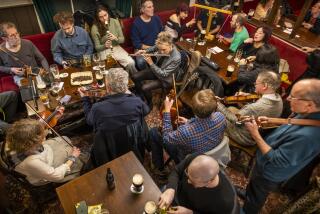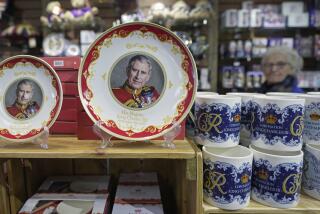London Towers Again on World Stage
- Share via
LONDON — Hiromi Stone has lived in New York, Los Angeles and Tokyo, but London is where she and her family have settled. The reasons still amaze her: The capital once known for its crumbling infrastructure, quaint historical sites and stiff-upper-lip traditionalism has become a thriving city with energy, wealth and ethnic diversity.
After more than a decade of remarkable economic success in Britain, London has been transformed by a booming housing market, widespread gentrification and consumer spending.
“It’s a financial capital with good restaurants, lively street markets and fairly safe streets. It has a mystique, a buzz,” said Stone, who works part-time helping expatriates settle here.
The city’s good fortune began in the 1980s when then-Prime Minister Margaret Thatcher introduced free-market reforms, making London’s financial center a draw for foreign investment. In today’s global market, it is second only to Wall Street, and it boasts Europe’s largest stock market -- even though Britain isn’t in the euro currency system.
Some analysts predict that Britain may one day overtake Germany as Europe’s largest economy, thanks to a growth rate expected to reach nearly 4% this year, about double that predicted for Germany. And that doesn’t even take into account Britain’s more flexible labor market, relative lack of red tape and lower unemployment.
Once known in the 1970s and ‘80s as “the sick man of Europe” because of economic problems, the capital, and country, now seem prosperous.
Stone, who is Japanese, owns a pricey apartment in central London with her American husband, an information technology specialist for a British bank. Their two children attend private schools that, like many others here, have a good number of foreign students.
London “offers Americans a chance to live in a European country that speaks English, where people aren’t as snotty as the French,” she said.
London is the second most expensive city in the world after Tokyo, and one reason is a housing boom. Thanks in part to low interest rates, national average house prices have risen 150% since 1995. Researchers said that was a key factor in the doubling of the number of millionaires in Britain over three years.
The top end of London’s housing market has long been a magnet for the super rich from around the world. The latest influx includes billionaire Russian oligarchs who have been snapping up mansions in Chelsea, Kensington and Belgravia.
“A couple of decades ago, Kensington was an infamous den of well-heeled Brits,” resident Gillian Tett wrote in the Financial Times. “But these days that stuffy contingent seems to be in a minority. Instead, the streets have become a Mecca for an international professional set: nouveau riche Russians; well-heeled Asians; a smattering of Arabs; and, above all, bankers, lawyers and other professionals from continental Europe and America.”
Signs of the new London, a city of 7.2 million, are everywhere.
A capital once infamous for second-rate food -- i.e., roast beef and tatties (mashed potatoes), fish ‘n’ chips, pasties -- is filled with restaurants that serve cuisine from around the world. Some are good enough to be ranked by the Michelin guide.
For years, many London pubs prospered by selling bitter -- flat, room-temperature beer from the tap -- in gloomy, if historic, rooms. Today, many have become trendy cafe bars that also serve bottled brews from around the world and wine.
In some ways, Britain, has succumbed, like other countries, to America’s cultural colonization of the world, with the importation of hip-hop music, TV sit-coms and Hollywood blockbusters. But recently, the New Yorker magazine advised readers that they shouldn’t miss new types of pop music emerging in England.
Like many other cities, London has its share of McDonald’s and Starbucks, and outlying areas have U.S.-style bargain supermarkets and shopping malls. But it still has thriving street markets such as Spitalfields, Portobello, Borough and Camden Lock, where people sell original designer clothes, antiques and organic foods.
The city’s skyline boasts new landmarks vying for attention with Big Ben, Buckingham Palace and the Tower of London. As late as the 1960s, building restrictions meant that the chimney of a power station on the south side of the River Thames could not top the dome of St. Paul’s Cathedral on the other side of the waterway.
Recently, the 41-story Swiss Re opened -- the first new office tower in London’s financial district in 25 years. A cigar-shaped glass tower, it earned the nickname “the gherkin” and became an instant icon of 21st-century Britain. The building can be seen from far beyond central London.
Three other skyscraper projects have been approved, including London Bridge Tower, a 66-story “shard of glass” that defeated opposition from traditionalists. When completed, it will be the tallest in Europe. For now, London’s tallest structure remains the 50-story One Canada Square, which was completed in 1991 in Canary Wharf, the capital’s satellite financial market on the east side of the city.
Like many observers, historian Cathy Ross says Britain’s longest period of uninterrupted economic growth since World War II is the main reason for the ongoing transformation of London. But she also cites other reasons.
For her, one turning point was Britain’s reaction to the death of Princess Diana in 1997.
“Suddenly, Britain’s stiff upper lip was gone,” Ross said in an interview at the Museum of London, where she works. “Hundreds of thousands of people were showing their emotions in public, engaging in an openly sentimental, public wallowing.”
She also thinks that the ancient city of London has such a strong sense of history -- complete with its narrow, medieval street pattern -- that it has no trouble reinventing itself with new money and modern architecture, without surrendering its character.
“How many other financial centers can you think of like London’s that are famous for their flower beds, the Barbican arts center, the London Museum? The history, the quality of life, the excitement of the capital, that’s what makes it far more exciting and attractive than more efficient, up-to-date cities such as Frankfurt and Tokyo, even though they have cleaner streets, more modern buildings, and far superior train and subway systems,” Ross said.
Like other analysts, Ross doesn’t know if London’s good times will last. Despite the city’s growing ethnic and racial diversity, immigration and asylum seekers remain a sensitive political issue in a city that suffered racial riots in the 1980s.
Some economists also have warned that the British boom could soon bust because rising interest rates seem to have hurt consumer spending in a country where many people are in debt with credit cards, mortgages and home equity loans.
But Ross said she believes that the economic turnaround and London’s prosperity have helped Britain shed its image as a has-been, a former colonial power, a winner of World War II that never fully recovered economically.
Chris Hamnett, a professor of social geography at King’s College London, agrees.
“Britain is now one of the most prosperous economies in Europe,” he said. It “often was seen as being plucky in adversity, of having won World War II, but not recovered from it anywhere like Germany and Japan.”
Turning to the computer in his office, Hamnett typed in “sick man of Europe” at the search engine Google. The most common result? Germany. “That baton has passed to someone else,” he said.
More to Read
Inside the business of entertainment
The Wide Shot brings you news, analysis and insights on everything from streaming wars to production — and what it all means for the future.
You may occasionally receive promotional content from the Los Angeles Times.










